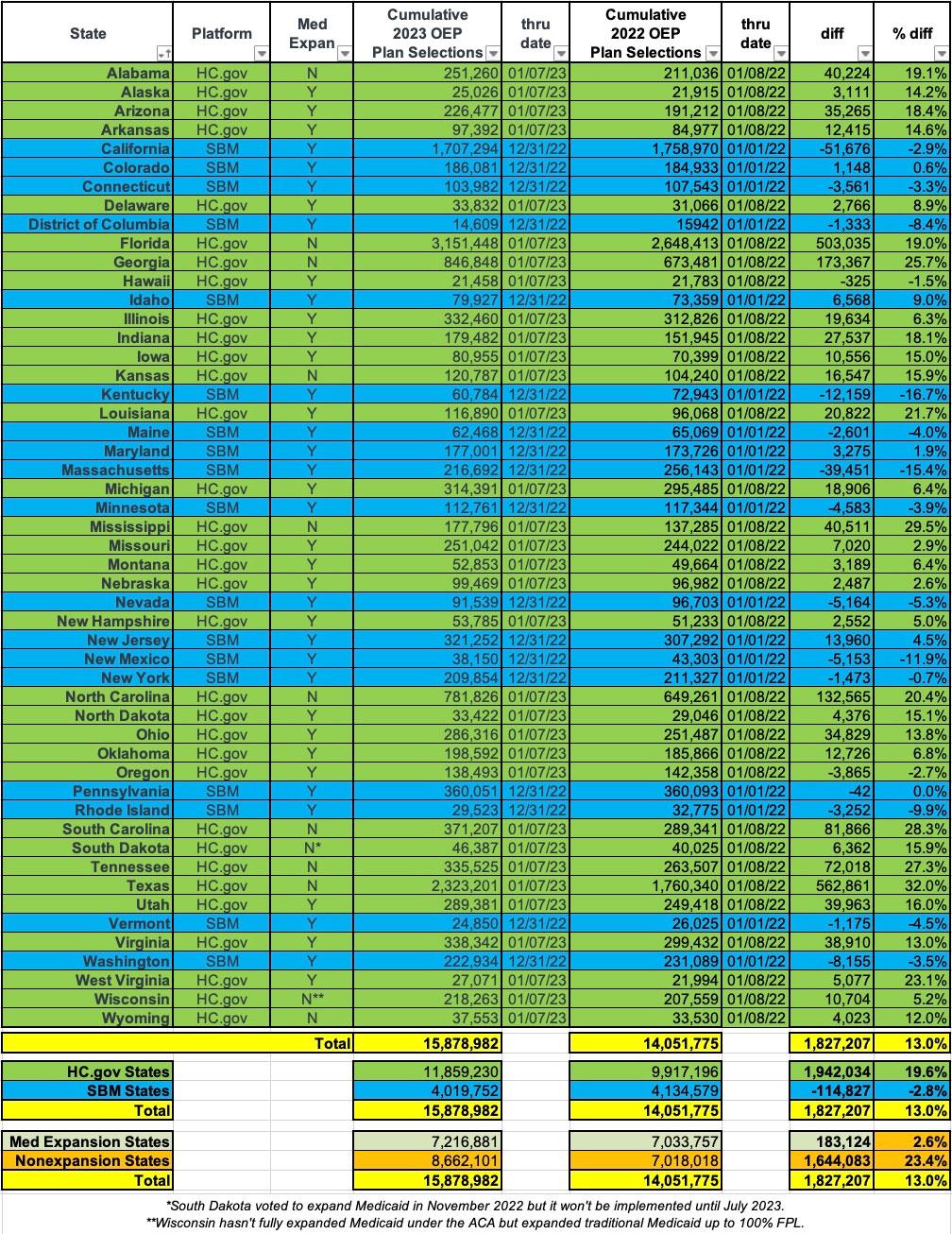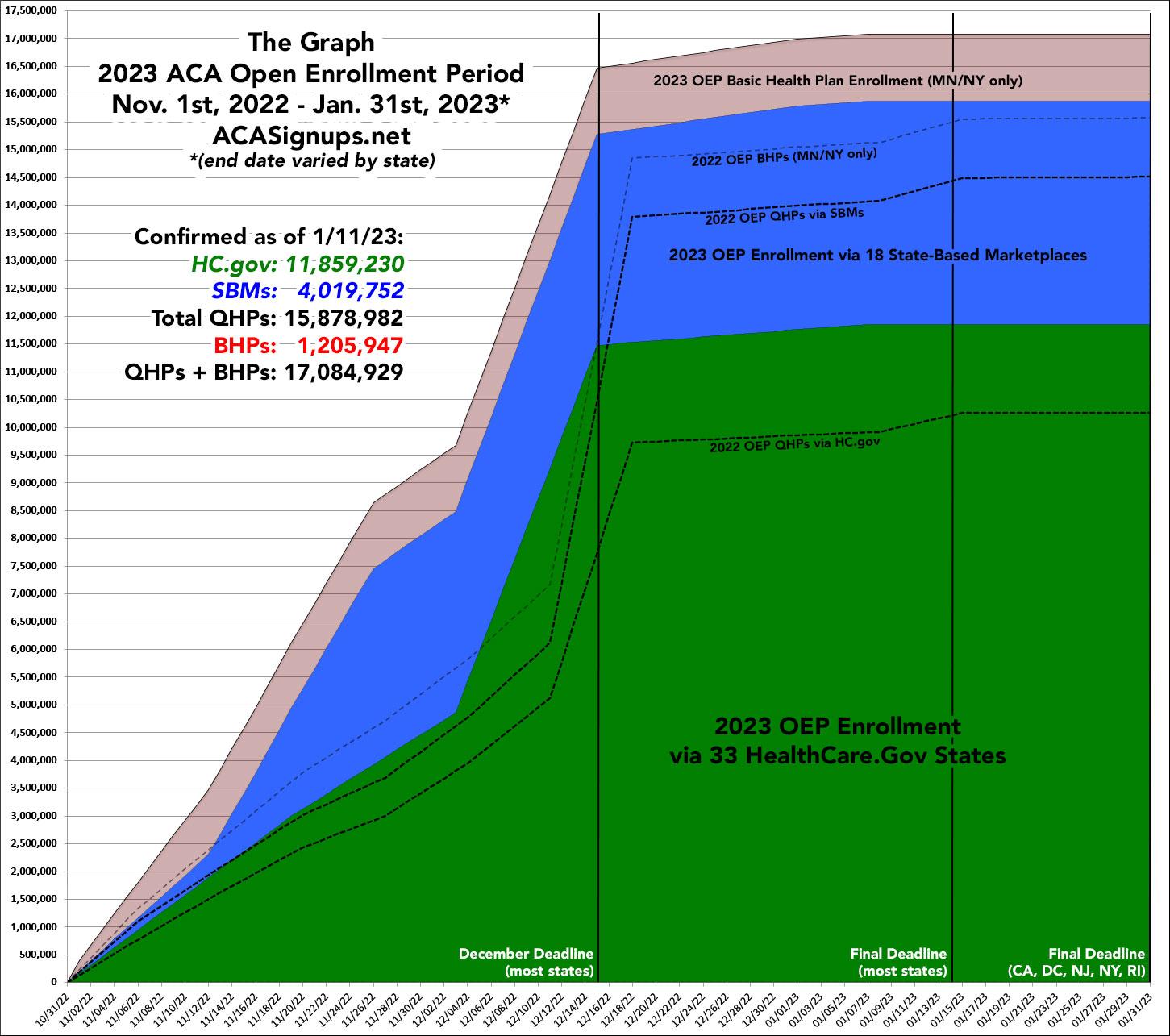BOOM: 2023 Open Enrollment breaks 17M w/BHPs included; up 13% y/y w/4 days left to #GetCovered!

via the Centers for Medicare & Medicaid Services:
Nearly 16 Million People Have Signed Up for Affordable Health Coverage in ACA Marketplaces Since Start of Open Enrollment Period
- This record-breaking enrollment represents a 13% increase over last year, including over 3 million people new to the Marketplaces.
- Open enrollment continues through January 15
Today, the Biden-Harris Administration announced that about 15.9 million people have selected an Affordable Care Act (ACA) Marketplace health plan nationwide since the start of the 2023 Marketplace Open Enrollment Period (OEP) on November 1. This represents activity through January 7, 2023 (Week 10) for the 33 Marketplaces using HealthCare.gov and through December 31, 2022 (Week 9) for the 18 State-based Marketplaces (SBMs) in 17 states and the District of Columbia that are using their own eligibility and enrollment platforms. Total plan selections include 3.1 million people (20% of total) who are new to the Marketplaces for 2023, and 12.8 million people (80% of total) who had active 2022 coverage and made a plan selection for 2023 coverage or were automatically re-enrolled. About 1.8 million more people have signed up for health insurance, or a 13% increase, from this time last year.
Note: It's buried at the bottom as a footnote (as usual), but in addition, over 1.1 million New Yorkers have enrolled in Basic Health Plan policies. While the footnote doesn't include Minnesota's BHP enrollment, the MN DHS website lists January enrollment as 103K.
Combined, that's nearly 17.1 million Americans who've signed up for either a Qualified Health Plan (QHP) or Basic Health Plan (BHP) nationally so far...and again, that's only through either December 31st or January 7th depending on the state. Open Enrollment continues through at least January 15th in most states and as late as January 31st in a few.
There's no state-by-state enrollment breakout included in the press release, and it hasn't been published to either the HHS or CMS websites yet; I expect this to be posted later on today and will update this entry when that happens. The 13% year/year increase refers to QHP enrollment only...but from what I can tell, BHP enrollment in NY & MN is more than 13% higher than last year as well, so there you go.
UPDATE: OK, CMS has indeed posted the press release publicly and, more importantly, has also posted the state-by-state breakout; see below for details.
“The Biden-Harris Administration has made expanding access to health insurance a key priority, and we are thrilled to see so many Americans enrolling in Affordable Care Act plans this year,” said HHS Secretary Xavier Becerra. “Thanks to President Biden’s Inflation Reduction Act, four out of five HealthCare.gov enrollees can find coverage for $10 or less. There are only five days left in Open Enrollment: do not miss your chance to enroll in high-quality, affordable health care. Start the new year off right and visit HealthCare.Gov today.”
"We continue to see historic enrollment numbers due to increased financial assistance from the Inflation Reduction Act and new eligibility for families, but we're not done yet," said CMS Administrator Chiquita Brooks-LaSure. “The Marketplace Open Enrollment Period isn’t over yet. There is still time to enroll or find a new plan for yourself or your family. I encourage all those looking for affordable, quality health care, or interested in exploring their options, to visit HealthCare.gov before the final deadline on January 15.”
The 2023 Marketplace OEP runs from November 1, 2022 to January 15, 2023 for Marketplaces using the HealthCare.gov platform. People generally need to submit an application and choose a plan by January 15 for their coverage to start February 1. State-based Marketplace enrollment deadlines vary and may be longer than the HealthCare.gov deadlines. State-specific deadlines and other information are available in the State-based Marketplace Open Enrollment Fact Sheet.
The Biden-Harris Administration has made expanding access to health insurance and lowering health care costs for America’s families a top priority, and under their leadership, the national uninsured rate reached an all-time low earlier this year.
The Biden-Harris Administration encourages all families to visit HealthCare.gov and check out the health care coverage options and savings available to them. This year, thanks to the Inflation Reduction Act, more people will continue to qualify for help purchasing quality health coverage with expanded financial assistance. Four out of five people returning to HealthCare.gov will be able to find a plan for $10 or less after tax credits. People with coverage through HealthCare.govare encouraged to return and shop to see if another plan better meets their needs at a lower cost.
Individuals will also benefit from a highly competitive Marketplace. Ninety-two percent of HealthCare.gov enrollees will have access to options from three or more insurance companies when they shop for plans. Also, new standardized plan options are available in 2023 through HealthCare.gov, which help consumers compare and select plans. Standardized plans offer the same deductibles and cost-sharing for certain benefits, and the same out-of-pocket limits as other standardized plans within the same health plan category. Most of these standardized plan options offer many services pre-deductible, including primary care, generic drugs, preferred brand drugs, urgent care, specialist visits, mental health and substance use outpatient office visits, as well as speech, occupational, and physical therapy.
Individuals can enroll or re-enroll in health insurance coverage for 2023 by visiting HealthCare.gov, or CuidadoDeSalud.gov, or by calling 1-800-318-2596 to fill out an application. Individuals wanting assistance signing up for coverage may go to Find Local Help on HealthCare.gov to find a Navigator, Certified Application Counselor, or agent or broker.
Marketplace Enrollment Snapshot Overview:
- Marketplace and Consumer Type / Cumulative 2023 OEP Plan Selections
- Total: All Marketplaces / 15,878,982
- New Consumers / 3,099,387
- Returning Consumers* / 12,779,595
- Total HealthCare.gov Marketplaces / 11,859,230
- New Consumers / 2,602,598
- Returning Consumers / 9,256,632
- Total SBMs** / 4,019,752
- New Consumers / 496,789
- Returning Consumers / 3,522,963
Find out more via key highlights and improvements and infographic for the Marketplace 2023 Open Enrollment Period. For more information about how to enroll in Marketplace coverage, visit HealthCare.gov, CuidadoDeSalud.gov or your State-based Marketplace.
* The returning consumers metric in this report only includes both consumers who have returned to their respective Marketplace through the reporting date and selected a plan for 2023 coverage, and consumers who have been automatically re-enrolled in their 2022 plan or a suggested alternate plan for 2023 coverage.
** In addition to reported plan selections, New York and Minnesota have a Basic Health Program (BHP), which generally provides coverage to consumers with household incomes up to 200 percent of the FPL who are not eligible for Medicaid or CHIP and otherwise would be eligible for a QHP. From November 1 – December 31, 2022, New York had a total of 1,102,838 individuals enroll in a BHP. Minnesota’s BHP data was not available at the time of this report.
Again: 15,878,982 QHPs + 1,102,838 NY BHPs + 103,109 MN BHPs = 17,084,929 total...over 13% higher than the same point last year if you match up the end dates (1/07 for 33 states; 12/31 for the other 17 states + DC).
In fact, total 2023 enrollment is nearly 10% higher so far than final 2022 OEP enrollment last year...and again, there's still up to 3 weeks left for people enroll for coverage starting February 1st this year.
Here's the 2023 vs. 2022 comparison as closely as I can figure it...it's not an exact apples to apples match because the thru dates are off a bit. HC.gov enrollment is actually up nearly 20% while the state-based exchanges are down slightly vs. the same point last year, which is the first time that's happened to my knowledge...but again, this isn't an exact match; we'll have to wait until the dust settles after January 31st to be certain:
Here's the state-by-state breakout:
As always, the main reason for the gap between federal exchange states and SBM states is that every state which hasn't expanded Medicaid yet is also hosted on the federal exchange (HC.gov). Medicaid expansion states saw a modest 2.6% year over year enrollment increase...but non-expansion states (including South Dakota, which passed Medicaid expansion last November but won't implement it until this July) saw a whopping 23.4% enrollment hike.
Texas has had the most dramatic enrollment increase, up a stunning 32% vs. last year. Much of this is no doubt due to the Premium Alignment law passed unanimously by the state legislature in an unusual show of bipartisanship, in a state which hasn't exactly been welcoming of the Affordable Care Act overall, to put it mildly.
Other major enrollment hikes have happened in Mississippi, South Carolina, Tennessee and Georgia, all of which saw enrollment spike by more than 25%. All of these are located in the South, and again, none of them have expanded Medicaid.
In terms of raw numbers, FLORIDA is once at the head of the pack, with over 3.15 million residents enrolled in on-exchange ACA policies. This represents an amazing 14.2% of the total population. It's followed by Texas, which has 2.32M enrollees so far, or 7.7% of its total population.
At the opposite end, the biggest year/year enrollment drop is in Kentucky, which has lost over 16% of its exchange enrollment, followed by Massachusetts and New Mexico, which are each down by double digits so far. Again, all of these are state-based exchanges which have expanded Medicaid. If you disregard New York and Minnesota (special cases since their BHP programs eat up most of their exchange enrollee populations), the state with the lowest percent of its total population enrolled in ACA exchange plans is also Kentucky, at just 1.3%.
Again, there's still time left for people to sign up in every state except Idaho, which ended Open Enrollment on December 15th. Assuming the ~13% y/y increase holds through the final end of OEP in every state on January 31st, that would put total QHP + BHP enrollment at nearly 17.6 million nationally when the dust settles, or roughly half a million higher than today's tallies.






